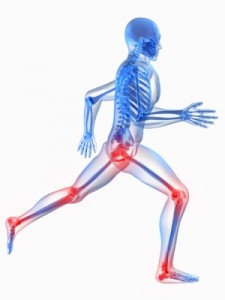The Why Behind The Injury
 The body is an incredibly complex organism. It boasts so many moving parts, it's a wonder that we get around at all. For us to perform at our best and to remain injury free, we need all of these parts to do their jobs properly. Unfortunately, that is a rare occurrence for many of us. If you've run for any length of time, you’ve become familiar with a whole new list of muscles and tendons you never learned about in high school biology. What can I say? Injuries are the mother of education.
The body is an incredibly complex organism. It boasts so many moving parts, it's a wonder that we get around at all. For us to perform at our best and to remain injury free, we need all of these parts to do their jobs properly. Unfortunately, that is a rare occurrence for many of us. If you've run for any length of time, you’ve become familiar with a whole new list of muscles and tendons you never learned about in high school biology. What can I say? Injuries are the mother of education.
Why are we getting injured? It's not as simple as saying, "Because we run." Running merely reveals what parts of our kinetic chains are weak.
For purposes of running, we can break our muscles into two different categories: muscles that move us and muscles that stabilize us. Our movers need to be both strong and flexible. Through their elasticity, we are able to apply greater energy return to the ground. Our stabilizers work like a suspension system. Think of our muscles like springs. Our movers are like the spring in a pogo stick: they collect and return energy to propel us forward. But our stabilizers are like the suspension system in a car, absorbing the impact forces and providing a smooth ride. Our stabilizers aren’t about propelling us along but making the ride as smooth as possible.
Now, imagine both our movers and stabilizers working in synchronicity at different rates and levels of relaxation and activation. It’s not hard to see how having just one moving piece slightly out of whack—whether it be in strength or flexibility—can lead to injuries and inhibited performance.
With all of these moving parts, how do we know what needs work? How do we know which piece is out of whack? Good question. All too often, we focus on treating the symptoms and not correcting the mechanisms that are causing the problem. We just assume that we're not cut out for running or that we’re cursed to limp or that we’re naturally slow. But humans are actually quite adept at running, and chances are you’re a better runner than you’re giving yourself credit for. Take a look at a few of these common issues and see if any of them sound familiar.
Are your calves causing your problems? They might be compensating for tight/weak hips. Does your lower back (SI joint) hurt? It could be a result of poor glute activation. Are your hip flexors tight? They’re preventing you from completing an efficient triple extension at toe-off.
Are your glutes and hamstrings tight or weak? They won’t be able to contract quickly enough to return your feet beneath your hips as you land, resulting in a shortened, less powerful stride.
Because we each have different strengths and weaknesses, our individual recipes for success will vary. The FLEET FEET Training Center has classes designed to address each of the key weakness and instability issues athletes face. Whether you need help with muscle activation, flexibility and range of motion, or a combination of both, our training staff will help you design a program to fit your goals, injury history, and lifestyle. As our saying goes, it's Training Centered on YOU.
Good Luck and Happy Racing!
Coach Cary
 Tim Cary is FLEET FEET's Assistant Training Manager, coach of the FLEET FEET-sponsored Runnababez Elite team, and manager of the FLEET FEET Racing Team. Over his 20 years of coaching, Tim has coached athletes to three national team championships, five national individual championships, two national records, and numerous All-American and All-State honors. Click here to receive Tim's weekly article via email.
Tim Cary is FLEET FEET's Assistant Training Manager, coach of the FLEET FEET-sponsored Runnababez Elite team, and manager of the FLEET FEET Racing Team. Over his 20 years of coaching, Tim has coached athletes to three national team championships, five national individual championships, two national records, and numerous All-American and All-State honors. Click here to receive Tim's weekly article via email.
Connect With Us
See the latest from Fleet Feet St. Louis